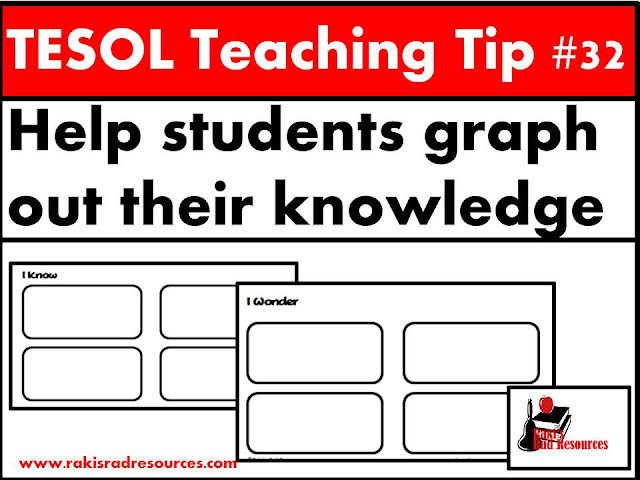My class this year consisted of 20 students, of which only 1 spoke English only in his household, and even he began his life in a bilingual environment. The other 18 spoke at least one, if not two other languages in their homes, and go to school in English, although they don’t live in an English speaking country. Due to my unique teaching position, I have had some readers ask for tips on teaching English Language Learners. Here’s this week’s Tuesday TESOL Teaching Tip:
ELL Teaching Tip #32: Graph Out Background Knowledge
All students come to your class with background knowledge. They may not come to you with the background knowledge that you desire, but they come full of background knowledge none the less. All students do better if they can connect what you are teaching to something that is familiar to them. However, for Language Learners, it may be the difference between if they remember a word for future use or not. Most times, it takes students 30 – 50 times of hearing a word before they begin to internalize it. However, if we connect the word to something in their background knowledge, they are able to internalize it faster. Some students are able to make their own connections with their own background knowledge. However, many students, especially at the elementary level, do not have this kind of meta-cogntion skill mastered. So, here are some ways to help your students connect what they are learning to what they already know:
1.) Allow students to complete a graphic organizer with “Stuff I Already Know” about a new topic. (Grab my graphic organizer for FREE from my Teachers Pay Teachers store.)
 Have students leave these graphic organizers on their desks, and while you are having class discussions or small group learning stations, take a moment to make a connection for each of your English Language Learners. For example: “Mya, I see you knew that princess wear crowns. Did you see the page in this book where it talks about what crowns are made of? That metal is called gold.” I know this seems like a lot of work, but if you do this a lot in the beginning of the year, students will begin to do it for themselves – and for each other, as the year progress.
Have students leave these graphic organizers on their desks, and while you are having class discussions or small group learning stations, take a moment to make a connection for each of your English Language Learners. For example: “Mya, I see you knew that princess wear crowns. Did you see the page in this book where it talks about what crowns are made of? That metal is called gold.” I know this seems like a lot of work, but if you do this a lot in the beginning of the year, students will begin to do it for themselves – and for each other, as the year progress.2.) Model making connections with a text or topic. Say things like “This story happens at a farm, and it makes me think of when I went to a farm to pick strawberries.” Then, give students a sheet to write down their own connections as you move through a topic. Again, this is one that is more work in the beginning of the year, but when students get a hang of it, it gets easier. (Be careful to allow students to come up with their own connections, as it is easy to depend on our own background knowledge and forget to zone in on what the KIDS know.)
3.) Let kids tell their own stories. Set aside some time periodically to let your kids tell you about their lives. The more you know about your children, the more you will be able to help guide them to their own connections. Also, during these conversations – see if you can bring them to connect what they are talking about, to something you worked on in class.
Does anyone else have a great way to connect between current knowledge and background knowledge?
 Do you enjoy the weekly TESOL Teaching Tips? Would you like to view an hour long presentation on this topic? I recently presented on Strategies for Teaching English Language Learners at the Everything’s Intermediate Expo. Now you can grab the presentation for just $3.95 from Teacher’s Notebook.
Do you enjoy the weekly TESOL Teaching Tips? Would you like to view an hour long presentation on this topic? I recently presented on Strategies for Teaching English Language Learners at the Everything’s Intermediate Expo. Now you can grab the presentation for just $3.95 from Teacher’s Notebook.Find more TESOL Teaching Tips here, and come back every Tuesday for a new tip!



No comments:
Post a Comment